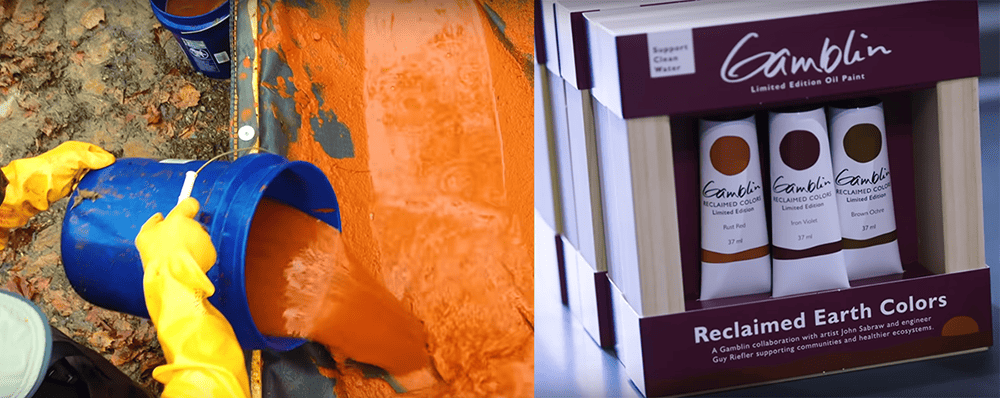
[Image above] Rural Action, an Appalachian-based nonprofit, is extracting iron oxide from acid mine drainage (left) and turning it into a marketable pigment (right). Credit: Business Insider, YouTube
The need for critical minerals and rare earth elements in advanced energy technologies has driven governments and companies around the world to pursue both traditional and emerging material sources in 2023. But as new mineral deposits are identified and opened for mining, concerns about the mines’ environmental effects are top of mind for local communities.
Acid mine drainage is a vivid example of how mining can damage the environment. Acid mine drainage is the formation and movement of highly acidic water rich in heavy metals due to mining activities. It occurs when sulfur-bearing minerals (mostly iron sulfides) are exposed to atmospheric oxygen, moisture, and acidophilic iron-oxidizing bacteria.
This exposure triggers a chemical reaction that produces dissolved iron and sulfuric acid, which leaches heavy metals from the ground. When this toxic mixture enters nearby streams, it turns the water a bright orange color (pictured below).

Cleaning water affected by acid mine drainage is an expensive process. Ideally, the company who owns the mine would be held accountable for cleanup. Unfortunately, acid mine drainage often occurs at abandoned mines in rural areas, where a lack of funding and enforcement by federal agencies leaves local communities with contaminated water that they cannot afford to remediate.
Rural Action, a nonprofit organization based in Appalachian Ohio, has a project that may make mine drainage cleanup an affordable process for rural communities. Called True Pigments, this project is commercializing a process to extract iron oxide from acid mine drainage and turn it into a marketable pigment.
The True Pigments project began when Guy Riefler, civil engineering professor at Ohio University, met John Sabraw, art professor at Ohio University. Over the course of a decade, they along with Michelle Shively MacIver, previously coordinator of Sunday Creek Watershed at Rural Action and now director of product development at True Pigments, developed the extraction and conversion process with a team of students at Ohio University.
The group achieved great success with this process on a small scale, as described on the project website. Now with funding from the Ohio Department of Natural Resources, they are constructing a water treatment facility along Sunday Creek, a tributary of the Hocking River that is polluted with acid mine drainage. Completion of the facility is expected in 2024.
Selling the drainage-sourced pigment for a dollar a pound should cover the facility’s costs, thus creating “a circular, sustainable process that pays for the cleanup of the streams,” Sabraw says in an article on The Ohio Newsroom.
Sabraw is already an avid user of the drainage-sourced pigment in his own artwork. Ever since the True Pigments project began, he has shifted from hyperrealistic oil paintings to abstract works that recall natural formations, such as winding rivers and shores.
“[This project] allowed me to enter a space where I can have an ongoing conversation with my environment, through paintings,” Sabraw says in The Ohio Newsroom article.
Learn more about the True Pigments project in the video below. The first product from the True Pigments project, a set of oil paints called Reclaimed Earth Colors, can be purchased on the project’s website.
